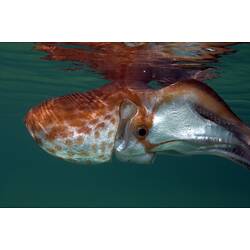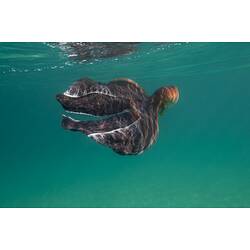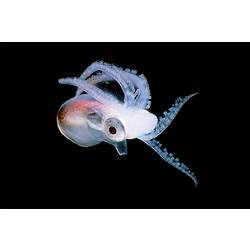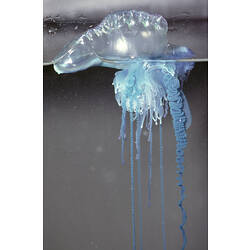General Description
The males and females of this free-swimming octopus look very different. The female can grow to a very large size and has expanded webs (or 'blankets') that unite her dorsal arms. When swimming, she can unfurl and trail these expansive webs, giving her an apparent total length of up to 2 m. The female has a round body and eight arms, the two dorsal arm pairs being the longest. Each arm has two rows of suckers. The male is much smaller than the female, never growing larger than a few centimetres. He has a rounded body and large eyes. He has eight arms, each with two rows of suckers. The third right arm is much longer and highly modified. It develops in a pouch between the funnel and right eye. Both males and females have two pairs of cephalic water pores, one pair located on the dorsal surface of the head and the second pair located ventrally adjacent to the funnel opening. Female mantle length to 32 cm, total length to approximately 1 m. Male mantle length to 16 mm.
Biology
Female tremoctopods are most frequently encountered swimming just below the water surface in the open ocean. When swimming, the female can trail her expansive dorsal webs. These webs are divided into sequential components, which can be autotomized (spontaneously cast off) as long free strips, potentially acting to distract approaching predators. Males and small females (smaller than 70 mm) usually carry fragments of nematocyst-bearing tentacles of the siphonophore Physalia (Blue-bottle or Portuguese Man-of-War). The fragments are held on the first two pairs of arms, in two rows that correspond to the two rows of suckers. It is not known whether the Physalia tentacle fragments are used to aid in food capture, defence or both. Mating in tremoctopods is very unusual. When a tiny male encounters a female, he ruptures a pouch containing a special reproductive arm. He loads this arm with sperm, detaches it and passes it to the female. Once the arm is shed, it is believed that the male dies. The detached arm crawls into the gill cavity of the female where it attaches to her gills and is stored until it is required for fertilisation. Females brood eggs within their arm crown and webs. The eggs are attached as strings to a secreted, mineralized rod. The female may carry egg strings representing up to five different developmental stages at a time, indicating prolonged spawning and high fecundity. The stomach contents of a stranded female was found to contain fish scales, cephalopod flesh, algae and polychaete jaws. The remains of tremoctopods have been recovered from the stomachs of a range of predators including fishes, marine mammals and birds.
Distribution
Indian and Pacific Oceans. Western and Eastern Australia, occasionally carried by currents as far south as Tasmania.
Habitat
Surface waters of open-ocean. May be encountered in shallow coastal waters or stranded on the beach.
More Information
-
Animal Type
-
Animal SubType
-
Brief Id
Red and silver octopus. Eight arms, females with expanded dorsal webs, males tiny.
-
Colours
Red, Silver
-
Maximum Size
1 m
-
Habitats
-
Diet
Carnivore
-
Diet Categories
Fish, Cephalopods, Worms
-
Hazards
Potential to bite, especially if handled. Venom status unknown.
-
Endemicity
-
Commercial
No
-
Depths
Shallow (1-30 m), Deep ( > 30 m)
-
Water Column Locations
Surface, Midwater
-
Taxon Name
-
Scientific Author
(Eydoux, F J; Souleyet, L F, 1852)
-
Common Name
Blanket Octopus
-
Phylum
-
Class
-
Subclass
-
Order
-
Suborder
-
Family
-
Genus
-
Species Name
gracilis






